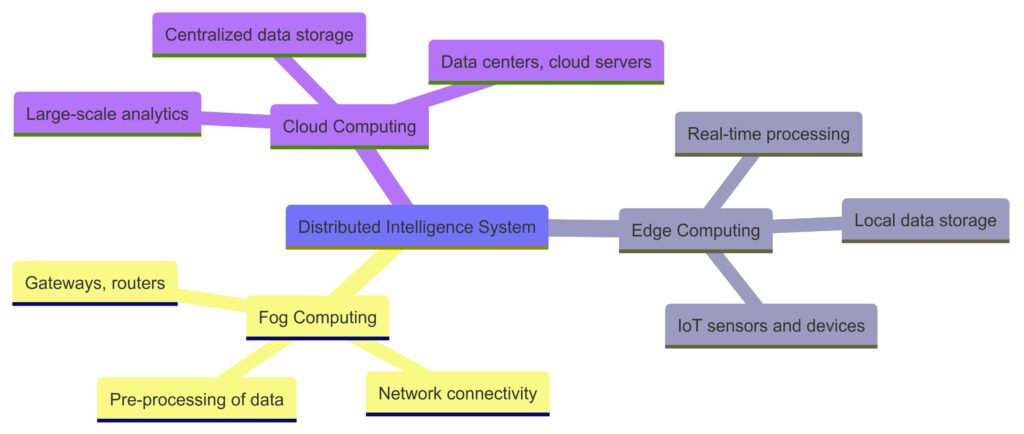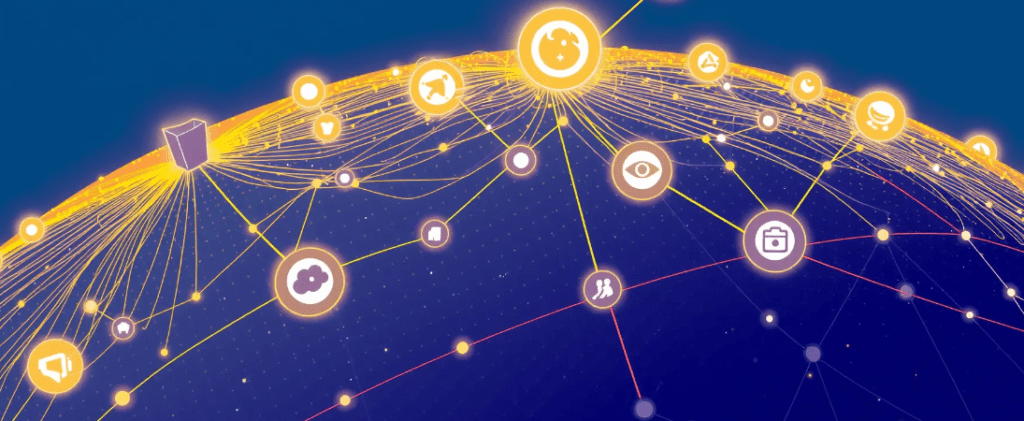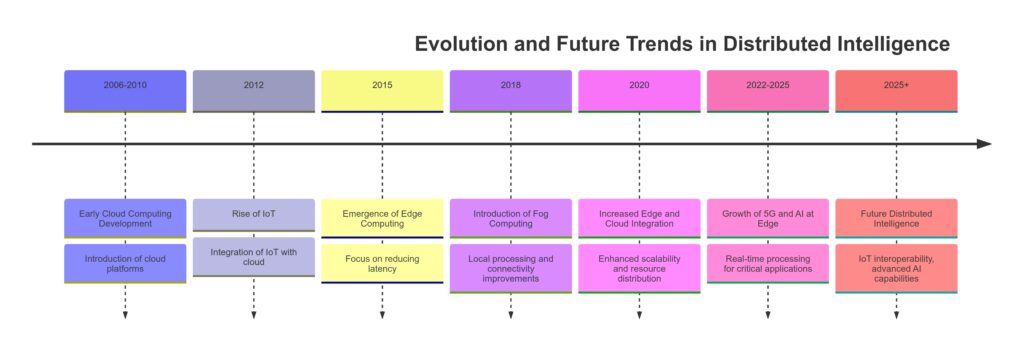
The rapid growth of data has pushed traditional computing frameworks to their limits. Distributed intelligence leverages edge, fog, and cloud computing to handle massive data flows, creating a streamlined, adaptable system for real-time data management.
This approach empowers organizations to gather, analyze, and act on information more efficiently, meeting the demands of fast-paced, data-driven environments.
Understanding Distributed Intelligence in Modern Computing
What Is Distributed Intelligence?
Distributed intelligence is the integration of computational power across various layers—edge, fog, and cloud—to process data where it’s generated. This setup minimizes delays and reduces the strain on centralized resources by distributing tasks intelligently among these computing layers. Rather than relying on a single cloud-based infrastructure, companies can achieve greater scalability and resilience.
The system enables each layer to function independently, enhancing redundancy while optimizing response times and bandwidth usage. By offloading computations and decision-making closer to data sources, distributed intelligence supports applications needing immediate action, such as IoT and smart manufacturing.
Edge, Fog, and Cloud Computing: A Breakdown
Edge Computing: Bringing Processing Power Close to Data Sources
Edge computing places computational resources at the location where data is generated, whether it’s a device, machine, or sensor. This proximity minimizes latency and allows for near-instantaneous data processing, critical for real-time analytics.
- Examples: Surveillance cameras processing video footage on-site, autonomous vehicles analyzing data in real-time for navigation.
- Benefits: Speed, real-time decision-making, reduced bandwidth usage.

Fog Computing: Bridging the Gap Between Edge and Cloud
Fog computing acts as an intermediary layer between edge devices and the cloud, handling tasks that require more resources than edge devices can offer but don’t need the full cloud infrastructure. This layer supports data aggregation, pre-processing, and immediate storage needs, easing the load on edge devices while reducing the volume of data sent to the cloud.
- Examples: Factory sensors feeding data to a fog server for localized analysis, enhancing predictive maintenance.
- Benefits: Reduced latency, lower bandwidth requirements, adaptable local data processing.
Cloud Computing: The Centralized Powerhouse
While edge and fog computing handle real-time or localized data, cloud computing remains essential for large-scale data storage, complex analytics, and centralized management. The cloud offers virtually unlimited resources, ideal for big data processing, AI training, and long-term storage.
- Examples: Storing and analyzing IoT data across multiple locations, running machine learning models on vast data sets.
- Benefits: Scalability, centralized data storage, advanced analytics, and integration across platforms.

Why Distributed Intelligence Matters in Data-Driven Industries
Enhanced Data Processing and Analytics
In distributed intelligence systems, data processing doesn’t solely occur in the cloud. Instead, edge, fog, and cloud layers collaborate, refining and analyzing data closer to its source when needed. This setup reduces latency and improves data accuracy for industries where real-time insight is essential, such as healthcare and autonomous transportation.
- Reduced Latency: By processing data at the edge or fog, critical insights are immediately accessible.
- Optimized Bandwidth: Less data needs to be transmitted to the cloud, easing network congestion.
- Improved Analytics: With processing distributed across layers, organizations can derive actionable insights faster.

Scalability and Flexibility for Evolving Applications
Distributed intelligence enables seamless scalability, a critical feature for industries expecting exponential data growth. By leveraging edge, fog, and cloud, organizations can meet demand without overhauling infrastructure, adapting resources dynamically as new devices or data flows enter the system.
- Scalable Infrastructure: Computing power can expand or contract across layers to match demand.
- Dynamic Resource Allocation: Resources are assigned based on real-time needs, enhancing efficiency.
- Future-Readiness: Distributed systems support evolving IoT ecosystems, from smart cities to remote healthcare monitoring.
Enhanced Security and Compliance
Each layer in a distributed intelligence system can be tailored for security and data privacy needs. Edge computing reduces the risk of transmitting sensitive data over networks, while fog and cloud layers offer sophisticated encryption and compliance features for secure, long-term storage and processing.
- Edge Security: Sensitive data remains on-site, minimizing exposure risks.
- Cloud Compliance: Cloud providers offer solutions for GDPR, HIPAA, and other regulatory standards.
- Data Integrity Across Layers: Encryption, authentication, and real-time monitoring ensure secure data transfer across all layers.
Real-World Applications of Distributed Intelligence
Healthcare: Enhancing Real-Time Patient Monitoring
In healthcare, distributed intelligence can support real-time patient monitoring with connected medical devices. Edge computing processes patient data directly on devices, while fog servers manage aggregated information within hospital networks, reducing latency and enabling rapid, localized decision-making.
- Immediate Analysis: Vital signs processed at the edge for alerts.
- Data Aggregation in Fog: Localized patient data stored securely and accessed instantly by caregivers.
- Long-Term Analysis in Cloud: Historical data in the cloud allows for comprehensive patient trend analysis and AI-driven insights.

Smart Manufacturing: Boosting Efficiency with Predictive Maintenance
Smart factories leverage distributed intelligence to optimize predictive maintenance. Sensors at the edge gather data from machinery, with fog nodes performing intermediate analysis and storing the data for localized insights. If further analytics are needed, the cloud can perform deep learning on historical data.
- Sensor Data at the Edge: Edge devices capture real-time machine data for instant anomaly detection.
- Fog Aggregation: Mid-level analysis detects patterns to trigger maintenance alerts.
- Cloud-Based AI Models: Historical data in the cloud enables advanced predictive analytics and trend analysis.
Benefits of Distributed Intelligence for Data Management

Reducing Latency for Real-Time Applications
In sectors where timing is everything, distributed intelligence minimizes latency by handling data locally or at intermediary fog nodes. This is crucial for applications like autonomous vehicles and industrial automation, where even a millisecond delay can impact performance.
- Localized Processing: Edge and fog layers perform calculations close to the data source, minimizing time delays.
- Critical for Fast Reactions: Distributed processing enables split-second decision-making in fast-paced environments.
- Bandwidth Efficiency: Less data is sent to the cloud, keeping network congestion low, which is especially helpful in remote or rural locations with limited connectivity.

Reduced Latency: Faster response times due to local processing.
Cost Savings: Lower costs with optimized resource usage.
Scalability: Ability to scale dynamically with demand.
Improved Security: Enhanced security through local data handling.
Cost Efficiency and Resource Optimization
By distributing processing tasks across different layers, companies can reduce their reliance on high-cost, centralized cloud resources. Edge and fog layers can handle basic analytics and filtering, allowing only critical or heavy-duty computations to take place in the cloud.
- Lower Data Transmission Costs: Data processed closer to its source decreases the need for continuous, high-volume cloud transfers.
- Reduced Cloud Dependency: Organizations pay only for essential cloud resources, saving on storage and bandwidth expenses.
- Optimized Resource Allocation: The distributed model ensures that each layer—edge, fog, and cloud—uses only what it needs for specific tasks, reducing waste.
Enhancing Reliability and Resilience in Data Processing
Distributed intelligence offers a redundant and resilient system for managing data, as each layer can independently support processing tasks if another layer encounters issues. For industries like utilities and telecommunications, this redundancy is essential to maintaining service continuity and reliability.
- Increased System Resilience: If the cloud is temporarily inaccessible, fog and edge layers can still operate effectively.
- Reduced Downtime: Critical processes can continue at the edge or fog layer, even during network outages.
- Adaptability: Distributed systems can adapt to local network disruptions, ensuring that essential operations remain functional.
Overcoming Challenges in Distributed Intelligence Integration
Managing Data Consistency Across Layers
One major challenge is ensuring data consistency across all three layers, especially with data coming from multiple sources. Data has to be synchronized accurately to prevent conflicts or inconsistencies, which can be complex when each layer operates independently.
- Data Synchronization: Implementing protocols to keep data consistent across layers is critical.
- Version Control and Metadata: Tracking versions and metadata across layers helps maintain accuracy.
- Periodic Cloud Sync: Regular cloud synchronization ensures that edge and fog layers stay updated without overloading the network.

Fog: Balanced challenges, moderate across all axes.
Cloud: High scores in Data Consistency and Storage Needs, indicating significant impacts in those areas.
Addressing Security and Privacy Concerns
Distributed intelligence exposes new entry points for cyberattacks, as data flows through various layers. Each layer must be secured independently, with measures in place to protect sensitive information at every point.
- Layered Security Protocols: Securing data at each layer with encryption, access controls, and firewalls.
- Edge-Level Privacy: Ensuring data privacy at the edge by keeping sensitive information local, avoiding transmission to the cloud.
- Fog and Cloud Compliance: Adhering to regulatory requirements for data storage and handling to meet standards like GDPR and HIPAA.
Balancing Network Bandwidth and Storage Needs
Handling large-scale data across edge, fog, and cloud layers can overwhelm network bandwidth and storage, especially as more IoT devices connect to the network. Efficient data management strategies are needed to balance resource usage across layers.
- Data Filtering at the Edge: Filtering data at the edge to retain only the most relevant information, reducing the load on higher layers.
- Adaptive Bandwidth Allocation: Managing bandwidth dynamically, assigning resources based on current demand.
- Cloud Storage Optimization: Cloud storage should be used primarily for long-term data, with less critical data retained at fog or edge levels to conserve resources.
Industry-Specific Use Cases for Distributed Intelligence
Autonomous Transportation: Navigating Complex Data in Real-Time
Self-driving cars rely heavily on real-time data processing to navigate roads safely, interpret surroundings, and respond to hazards. By integrating edge, fog, and cloud computing, these vehicles can process data locally while remaining connected to the cloud for broader information, such as traffic updates and route changes.
- Edge Computing on Board: Cameras and sensors within the vehicle process local information in real-time for navigation.
- Fog Nodes for Local Traffic Data: Fog nodes positioned in local areas aggregate data from multiple vehicles, providing area-specific insights.
- Cloud-Connected Updates: The cloud stores large datasets on road conditions, weather patterns, and accident reports, supporting the broader traffic ecosystem.
Retail and E-Commerce: Enhancing Customer Experiences with Personalization
Retailers increasingly use distributed intelligence to create personalized shopping experiences. By processing data at the edge (in-store or on apps), companies can offer real-time recommendations and manage stock levels efficiently.
- Edge-Level Insights: In-store data collected from sensors and cameras enables real-time customer insights, supporting on-the-spot marketing.
- Fog for Regional Data Analysis: Regional fog nodes analyze buying trends and adjust inventory for local preferences.
- Cloud Analytics for Market Trends: Long-term analysis in the cloud helps retailers understand broader trends and optimize stock globally.
Agriculture: Optimizing Crop Yields with Smart Farming Solutions
Smart farming uses distributed intelligence to monitor and manage crop conditions across vast agricultural lands. Sensors at the edge monitor factors like soil moisture, temperature, and nutrient levels, while fog nodes handle localized data processing and the cloud enables long-term trend analysis.
- Edge for Field Sensors: Soil and weather data are gathered and processed directly in the field for immediate crop management.
- Fog-Based Regional Monitoring: Fog servers aggregate data from multiple fields, identifying larger-scale patterns and alerts.
- Cloud for Long-Term Planning: Historical data stored in the cloud supports planning for crop cycles, water use, and pest control, making farms more efficient over time.
Future Trends in Distributed Intelligence and Data Management
AI and Machine Learning at the Edge
Advances in AI are pushing more machine learning capabilities to the edge, enabling devices to make complex decisions on the spot. As hardware improves, edge devices will increasingly be able to process AI models directly, reducing dependency on cloud-based ML processing.
- AI in Real-Time: Real-time decision-making enables fast responses, such as facial recognition in security systems.
- Reduced Cloud Reliance: Moving ML to the edge decreases latency and data transmission costs.
- Privacy Benefits: Sensitive data can be processed without leaving local devices, supporting data privacy.

Growing Demand for Interoperability Across Systems
As distributed intelligence expands, interoperability between systems and devices will be critical. Companies will need systems that can integrate seamlessly across diverse technologies, from sensors to cloud platforms, to harness the full potential of distributed intelligence.
- Standardization Efforts: Industry standards will be needed to facilitate communication between devices, edge, fog, and cloud systems.
- Enhanced API Use: Open APIs can help systems “talk” to each other, making integration smoother.
- Cross-Platform Data Sharing: As industries adopt distributed intelligence, standardized data formats will support compatibility across platforms.
Advancements in 5G and Beyond for Distributed Systems
The rise of 5G networks promises faster, more reliable connectivity, making distributed intelligence even more powerful. With improved bandwidth and low latency, 5G supports high-speed data transmission, essential for applications requiring real-time responses, such as remote surgery and autonomous drones.
- Faster Data Transfer: 5G enables quicker data sharing across edge, fog, and cloud.
- New IoT Possibilities: Low-latency 5G allows IoT devices to operate seamlessly within distributed systems.
- Improved Data Reliability: Enhanced connectivity will reduce network interruptions and improve overall system reliability.
By embracing distributed intelligence and its many capabilities, industries can adapt to the growing data demands of today and tomorrow. With edge, fog, and cloud computing working in harmony, organizations can enhance responsiveness, reliability, and security, preparing them to thrive in an increasingly data-centric world.
Conclusion: The Power of Distributed Intelligence for Modern Data Management
The combination of edge, fog, and cloud computing in distributed intelligence empowers organizations to process, store, and analyze data with greater efficiency and adaptability than ever before. By distributing tasks across multiple layers, companies can enjoy real-time responsiveness, scalability, and cost-effectiveness while minimizing latency and improving security.
In industries as diverse as healthcare, transportation, agriculture, and retail, distributed intelligence is transforming operations by enabling swift, data-driven decision-making at every level. Real-time processing at the edge, intermediate analysis in fog nodes, and advanced analytics in the cloud combine to create a seamless, dynamic system for managing data in fast-paced, data-intensive environments.
As 5G technology advances and AI capabilities continue to expand at the edge, distributed intelligence will only become more powerful, providing industries with tools to meet the demands of tomorrow’s digital landscape. Organizations that embrace this architecture will be well-prepared to handle growing data flows while remaining agile, responsive, and efficient.
For businesses looking to stay ahead, adopting distributed intelligence is no longer a luxury—it’s a necessity.
FAQs
How does edge computing differ from fog computing?
While both edge and fog computing bring data processing closer to the source, they serve slightly different roles. Edge computing operates directly on data-producing devices or sensors, enabling real-time responses with minimal latency. Fog computing, on the other hand, serves as an intermediary layer, managing data locally in small-scale networks before sending it to the cloud. Fog computing is ideal for applications requiring data aggregation and mid-level processing in real-time without relying entirely on the cloud.
What are the benefits of using distributed intelligence in industries?
Distributed intelligence offers numerous benefits, including reduced latency, cost savings, scalability, and enhanced data security. By processing data at different levels—edge, fog, and cloud—businesses can lower costs associated with data transmission and cloud storage. It also ensures real-time decision-making and improves system reliability, as each layer can function independently in the event of network or connectivity issues. These benefits make it a valuable tool in fields like healthcare, manufacturing, retail, and autonomous transportation.
Is distributed intelligence secure?
Yes, distributed intelligence can be very secure when each layer is designed with robust security protocols. Data processed at the edge minimizes exposure to external networks, reducing vulnerability, while fog and cloud layers can implement encryption, access controls, and compliance standards such as GDPR and HIPAA. By securing each layer separately, organizations can effectively protect data across all layers of a distributed intelligence system.
What role does 5G play in distributed intelligence?
5G enhances distributed intelligence by providing faster, more reliable connectivity, which is essential for applications that require real-time responses and handle large data volumes. 5G’s high bandwidth and low latency make it easier for edge, fog, and cloud components to communicate seamlessly. This enables faster decision-making in applications like smart cities, autonomous vehicles, and remote surgery, where delays can have significant impacts on performance and safety.
How can distributed intelligence improve data management in smart cities?
In smart cities, distributed intelligence supports a wide range of applications, from traffic management to environmental monitoring. By processing data at the edge and fog layers, smart cities can analyze information from sensors and cameras in real-time, allowing for quick responses to traffic conditions, air quality changes, and emergency situations. Cloud computing supports the long-term analysis of these data patterns, enabling smarter planning and resource allocation.
What are the challenges in implementing distributed intelligence?
Some challenges of implementing distributed intelligence include data consistency, security across multiple layers, and balancing bandwidth and storage needs. Synchronizing data across edge, fog, and cloud layers is complex and requires efficient protocols to prevent inconsistencies. Additionally, securing data at each layer is essential to protect against cyber threats, as each layer introduces unique security needs. Finally, managing network resources across a large number of connected devices can strain bandwidth and storage capacities, requiring careful planning and resource allocation.
Why is distributed intelligence essential for the future of IoT?
Distributed intelligence is vital for IoT because it enables real-time data processing and decision-making close to where data is generated, reducing latency and improving responsiveness. IoT applications, such as connected healthcare devices or smart home systems, generate vast amounts of data continuously, which can be costly and inefficient to send solely to the cloud. By distributing processing tasks across edge, fog, and cloud layers, IoT systems can operate more effectively and at a lower cost, supporting more advanced, data-driven applications.
How does distributed intelligence support real-time decision-making?
Distributed intelligence enhances real-time decision-making by processing data closer to where it’s generated. When edge devices (like sensors or cameras) perform immediate analysis, they can make split-second decisions without waiting for data to travel to the cloud. For tasks requiring slightly more computational power, fog nodes provide additional localized processing, supporting fast responses to time-sensitive situations. This is essential in fields like autonomous driving, smart factories, and telemedicine, where even small delays can be critical.
Can distributed intelligence help with cost savings?
Yes, distributed intelligence can significantly reduce operational costs. By handling data processing at the edge and fog layers, organizations reduce the volume of data that must be sent to and processed in the cloud, which can be expensive. Edge and fog computing enable data filtering and pre-processing, so only essential information goes to the cloud, reducing bandwidth costs. Additionally, distributed intelligence allows for on-demand scalability, meaning companies pay only for the resources they need as they grow, making it a cost-effective solution for expanding data needs.
What’s the difference between cloud computing and distributed intelligence?
Cloud computing centralizes data storage and processing on remote servers, requiring data to travel back and forth between the source and the cloud. While this model offers vast resources and computing power, it often introduces latency and is less ideal for applications needing immediate responses. Distributed intelligence, however, distributes processing tasks across edge, fog, and cloud layers, allowing data to be analyzed and acted upon locally before it reaches the cloud. This layered approach improves speed, reduces data transfer costs, and is particularly useful for real-time applications like IoT and smart cities.
How does fog computing handle data storage?
Fog computing handles data storage by aggregating and temporarily storing data from edge devices in localized nodes. These nodes process and store data that may only be relevant for a short period, like sensor readings or localized analysis. This approach reduces the need for continuous cloud uploads and supports short-term data retention close to the source. Fog computing acts as an efficient middle ground, storing only necessary information locally, while more extensive or long-term data gets passed on to the cloud for comprehensive storage.
How can distributed intelligence improve industrial automation?
In industrial automation, distributed intelligence enables real-time monitoring and predictive maintenance by processing data on-site at factories or manufacturing plants. Edge devices can detect anomalies in machinery instantly, while fog nodes aggregate and analyze data from various machines for mid-level analytics. This reduces downtime by predicting maintenance needs before failures occur and improves production efficiency through real-time insights. Long-term data is stored in the cloud, helping factories optimize operations over time based on historical data and trends.
Is it possible to implement machine learning in a distributed intelligence system?
Yes, machine learning can be effectively implemented in a distributed intelligence system. Basic machine learning models can run on edge devices, allowing for real-time decision-making without needing cloud access. For example, an edge device could use a trained model to identify defects in products on an assembly line. Fog computing can support more complex models, while the cloud can handle training and refining large-scale models with vast datasets. As AI and hardware improve, more advanced machine learning capabilities will increasingly be possible at the edge and fog levels.
How does distributed intelligence enhance data privacy?
Distributed intelligence enhances data privacy by allowing sensitive information to be processed locally, reducing the need to send it to the cloud where it might be exposed to security risks. For instance, edge devices can process personal data, like health metrics from a wearable device, on the device itself, keeping it secure from external threats. In scenarios where data must be shared, fog and cloud layers provide encrypted transmission and storage options, protecting information across the entire system. By minimizing cloud reliance, distributed intelligence can better control and protect sensitive data.
How scalable is distributed intelligence for growing businesses?
Distributed intelligence is highly scalable, as organizations can expand their data management capabilities by adding more edge devices, fog nodes, or cloud resources as needed. For businesses experiencing rapid growth or seasonal data spikes, the distributed model allows them to scale up only where necessary, saving on costs. This flexibility makes distributed intelligence an ideal solution for evolving industries, such as e-commerce and telecommunications, that regularly see changes in data demands. By scaling resources at each layer as needed, businesses can adapt quickly without sacrificing performance.
Resources
Online Courses
- Cloud, Edge, and Fog Computing on Coursera (offered by the University of Illinois)
(Available on Coursera) - Introduction to Edge Computing by IBM on edX
(Available on edX) - Microsoft Azure IoT Developer: Configure Device Networking on Pluralsight
(Available on Pluralsight)
Articles and Whitepapers
- The State of Edge by the Linux Foundation
(Annual report on trends in edge computing) - Fog Computing and the Internet of Things: Extend the Cloud to Where the Things Are by OpenFog Consortium
(Available on the OpenFog Consortium website) - Distributed Intelligence for Data-Driven Decision Making by Intel
(Available on Intel’s website)
Websites and Industry Blogs
- Edge Computing World Blog
(News and insights on edge computing) - OpenFog Consortium
(Part of the Industrial Internet Consortium, offering resources on fog computing) - IBM’s Internet of Things Blog
(Covers topics on IoT, edge, and fog computing)
Research Papers
- Fog Computing: Principles, Architectures, and Applications by S. Yi, Z. Hao, and Q. Zhang
(Available on IEEE Xplore) - Edge Computing and Distributed Intelligence for the Industrial Internet by C. Linnhoff-Popien and S. Ziegler
(Available on ResearchGate)
Conferences and Events
- Edge Computing World
(Annual event on edge and fog computing) - IEEE International Conference on Fog and Edge Computing (ICFEC)
(Covers latest developments in fog and edge computing) - Industrial Internet Consortium (IIC) Events
(Focuses on IoT and distributed intelligence standards and research)